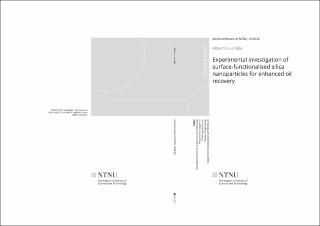| dc.description.abstract | Enhanced oil recovery (EOR) using nanoparticles (NPs) has been proposed as a solution in the petroleum industry to overcome declining production rates. Research has shown that commercially available hydrophilic silica NPs, manufactured by Evonik Industries, as additives to water flood can increase oil production from oil reservoirs. However, recent advances show that surface modification can further improve the microscopic sweep efficiency of NPs due to improved solubility and stability, greater stabilisation of emulsions, and low retention on porous medium compared with bare nanoparticles. The hypothesis above was the initiation of the present project. Evonik Industries developed twenty-three different types of silica nanoparticles with surface functionalities for oil recovery applications. The NPs were supplied to us as special research and development products under the name AERODISP®, or more precisely AEROSIL® particles in liquid solution.
Twenty-three unique glass micromodel injection configurations were conducted as a preliminary NPs screening step in the secondary recovery mode. The NPs with the greatest EOR potential were further evaluated using water-wet and neutral-wet Berea sandstone rocks, totalling sixty-seven successful core flooding configurations. Finally, the most promising samples were tested at a minimal reservoir temperature of 60 °C in tertiary recovery mode. Experimental nanofluids stability, interfacial tension and wettability tests, as well as the analyses of the differential pressure throughout the core, were performed to gain insight into the mechanisms by which nanofluids increased oil recovery. The nanofluids were prepared at 0.1 wt% concentration in seawater. Crude oil was obtained from a North Sea field.
The overall screening process identified four types of silica NPs with the greatest oil production potential. Interestingly, all NPs were coated or modified with polymer molecules, resulting in polymer-coated nanoparticles. The NPs were stable at room temperature (22 °C) for over four months in seawater, but they failed to hold long-term stability at the assumed reservoir temperature (60 °C). They remained stable for up to four days storage-time at reservoir temperature. Never theless, flooding experiments demonstrated that the NPs can mobilise residual oil and increase oil recovery. In addition, the experiments revealed that the NPs were efficient in enhancing oil recovery from water-wet Berea sandstone, and the recovery was greatest at high temperature. The oil recovery factor greater than 5% of OOIP was only achieved at the expense of large pore volumes of injected nanofluids.
An analysis of displacement mechanisms due to nanofluid injection suggested that oil recovery occurred through synergistic effect of reduced interfacial tension, increased structural disjoining pressure and wettability alteration, generation of insitu oil emulsion droplets and microscopic flow diversion due to clogging of the pores. At present, the contribution of these displacement parameters may not be fully isolated. However, the formation of NP-stabilised emulsion and log-jamming effect appeared to be the main influencing parameters for oil recovery from waterwet Berea sandstone rocks; While wettability alteration was the most relevant oil drive mechanism for any of the NPs in neutral-wet Berea sandstone.
Future studies are recommended to focus on the characterisation of surface activity and reactivity of the surface/coating additive materials at reservoir conditions to predict their interactions with base fluids, the binding with NPs, and with the reservoir rock. This will further improve the understanding of how NPs contribute to the mobilising of residual oil. | |
